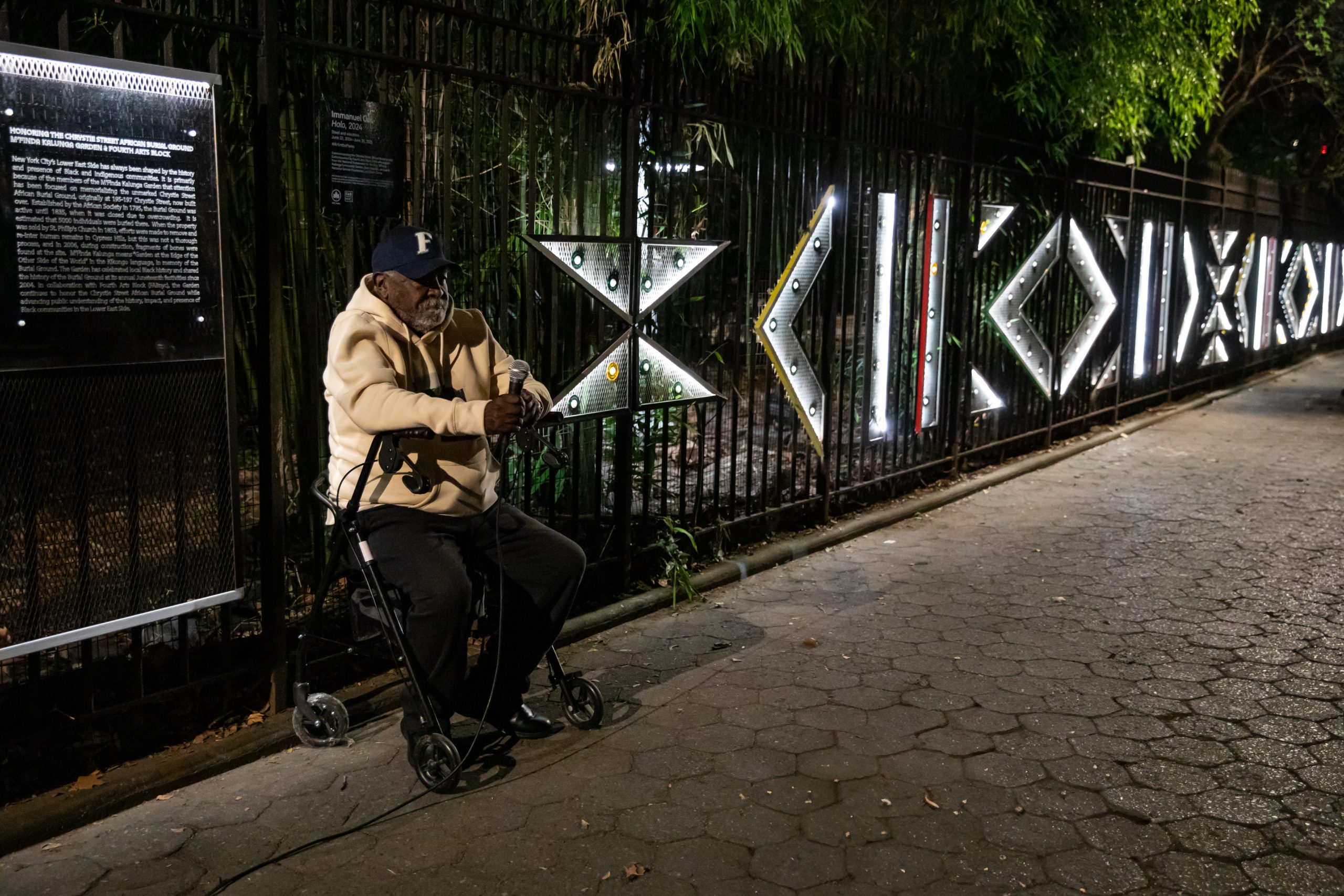
by Immanuel Oni
commemorating the Chrystie Street African Burial Ground.
Commissioned by Fourth Arts Block (FABnyc)
with support from
Debra Jeffreys-Glass
M’Finda Kalunga Community Garden
BEAM Center
Buro Happold
NYC Parks Department Art in the Parks Program
Jacques & Natasha Gelman Foundation
and the National Endowment for the Arts
PROJECT TEAM
Artist and Project Leader: Immanuel Oni
Project Producer: Ryan Gilliam (FABnyc)
Production Director: Stephen Callendar (BEAM Center)
Lighting Consultants: John Sloane, Maya Hladisova (Buro Happold)
Garden Liaison: Debra Jeffreys-Glass
Project Administration: Dakota Scott, Ari Duong Nguyen, Lena Feliciano Hansen (FABnyc)
NYC Parks / Art in the Parks Liaison: Elizabeth Masella
Review Committee: Amy Andrieux (Museum of Contemporary African Diaspora / MoCADA), Tomie Arai, Laura Lee (Tenement Museum), Debra Jeffreys-Glass
Commission Finalists: Laura Gadson, Nyssa Chow, Ali Santana
SPECIAL THANKS
Bob Humber
Members of M’Finda Kalunga Community Garden
Sara Roosevelt Park Coalition
Brian Cohen (BEAM Center)
Dennis Redmoon Darkeem
Resistance Revival Chorus
About the Chrystie Street African Burial Ground

New York City’s Lower East Side has always been shaped by the history and presence of Black and Indigenous communities. It is primarily because of the members of the M’Finda Kalunga Garden that attention has been focused on memorializing the unmarked Chrystie Street African Burial Ground, originally at 195-197 Chrystie Street, now built over. Established by the African Society in 1795, the Burial Ground was active until 1835, when it was closed due to overcrowding. It is estimated that 5000 individuals were buried there.
When the property was sold by St. Philip’s Church in 1853, efforts were made to remove and re-inter human remains in Cypress Hills, but this was not a thorough process, and in 2006, during construction, fragments of bones were found at the site.
M’Finda Kalunga means “Garden at the Edge of the Other Side of the World” in the Kikongo language, in memory of the Burial Ground. The Garden has celebrated local Black history and shared the history of the Burial Ground at its annual Juneteenth festivities since 2004. In collaboration with Fourth Arts Block (FABnyc), the Garden continues to honor the Chrystie Street African Burial Ground while advancing public understanding of the history, impact, and presence of Black communities in the Lower East Side.
About HALO by Immanuel Oni

During the 1800s, at night, the “lantern law” required African-Americans and Indigenous people in New York City to carry a candle or lantern on the street after curfew in order to make their presence known. HALO reclaims this archaic form of surveillance by illuminating Black spaces, beginning with the Chrystie Street African Burial Ground, honored and celebrated by the neighboring M’Finda Kalunga Garden community.
Using existing infrastructure, HALO embeds symbols and narratives into and around the perimeter of the Garden. Like a halo, a decorated light shade is wrapped around a vintage light post emanating light, African textile patterns, and names of those buried. A map is integrated to show other local sites of remembrance. The light pole is placed in Bob Humber’s garden plot to commemorate his 40 years of service to the Garden and community.

IMMANUEL ONI is a first-generation Nigerian-American artist and space doula living between New York City and hometown Houston, TX. He believes design is not about what he is making, but who he is making it for. As for art, it is religion. His work explores loss, memory, and its deep connection with space. He utilizes spatial justice design and visual storytelling to unearth narratives related to trauma, healing, and ritual. His canvas consists of repurposing existing public space infrastructure such as light posts, fencing, underutilized green areas or mobile spaces to prompt community dialogue and connection. His aim is to fuse the physical with the spiritual. He has led and participated in international art and urbanism workshops in Venice, Hong Kong, and Lagos. He has been a Fellow for the Design Trust for Public Space, Culture Push, New York for Culture and Arts, More Art Engaging Artist Commission NY, and received awards from Naturally Occurring Cultural Districts NY, Office of Neighborhood Safety, Architectural League of New York, the New York State Council of the Arts, and commissioned by Fourth Arts Block (FABnyc) as the artist for the Chrystie Street African Burial Ground Memorial Installation in the Lower East Side. He is a former Director of Community Design at the New York City’s Mayor’s Office of Criminal Justice and Adjunct Professor at Parsons the New School for Design. He is the co-founder and Creative Director of Liminal, a non-profit that works at the intersection of art, unity, and space
FOURTH ARTS BLOCK (FAB) is a team of artists and organizers working to preserve, strengthen, and grow the cultural vibrancy of the Lower East Side.




